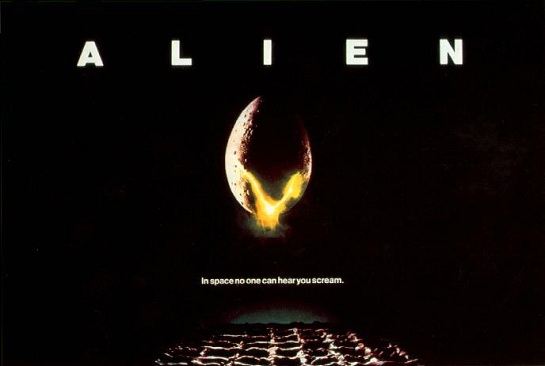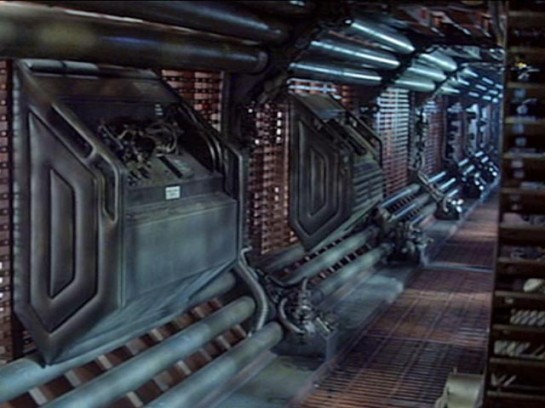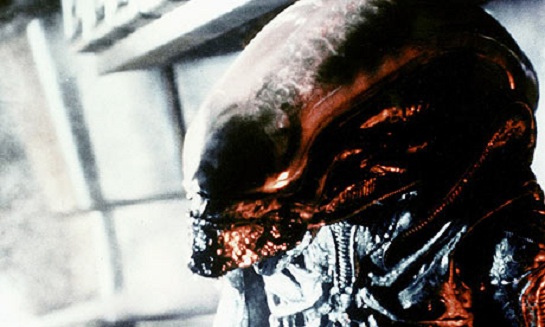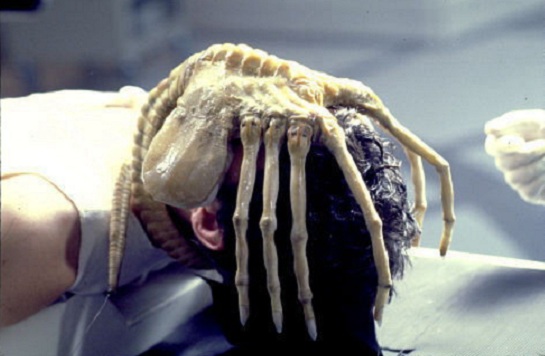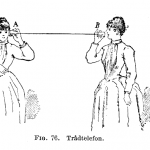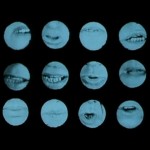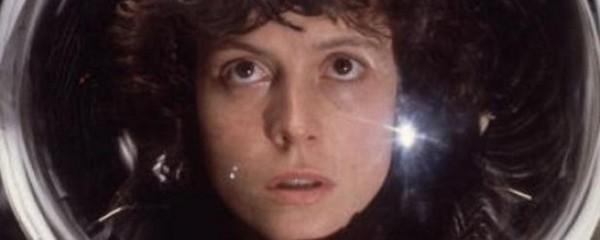
‘Building Better Worlds’: the production design of Alien
Culture, Design, NostalgiaRidley Scott’s groundbreaking science fiction-horror film Alien (1979) explores the deep fears and desires that are usually suppressed within the subconscious. The film delves deep into the human psyche and explores primordial fears about the body, birth and sexuality. Ridley Scott is renowned as a great visual stylist. Whether imagining the future in Alien and Blade Runner (1982), or resurrecting the ancient world in Gladiator (2000), the design of his films is remarkable. Scott’s films are often criticised as victories of style over substance, but this criticism is misguided: a film’s visual style is part of its substance and is central to how the film communicates with the audience. Ridley Scott’s real talent is in creating fully-convincing worlds. This article analyses the production design of Alien, arguing that the film’s human characters are caught between two extremes – the technology of the ship and the monstrous organicity of the alien. These films are conveyed through the production design, which is split between the visual futurism of Ron Cobb and the unsettling biomechanical aesthetic of H.R. Giger.
Production design
Alien was conceived as a gothic horror film set in space and much of the production design evokes a gothic atmosphere. The film is set aboard the Nostromo, a commercial towing vehicle drifting through deep space. The ship is essentially a giant oil-refinery, but Scott wanted it to look like a gothic cathedral floating in space. Built as a miniature model, the Nostromo features towers covered with intricate filigree detail reminiscence of Notre Dame in Paris. Inside, the corridors are gloomy and labyrinthine, representing a technological version of the subterranean tunnels of gothic horror. Of course, a space ship is the perfect location for a horror film because it is a place of absolute isolation and forms a pressurised environment, which creates an intense claustrophobia. The film’s tagline was ‘In space, no-one can hear you scream.’
The film’s production design was groundbreaking and two conceptual artists were responsible for it. First of all, Ron Cobb was hired to design the human environments, the ship and the hardware of the future. Cobb’s work was admired because it was logical and realistic, and he approached the film as an industrial design challenge. All of his designs look as if they could actually function; he even designed safety signs for fixtures such as airlocks. Cobb’s designs for the bridge and medical bay were reproduced as full-scale sets.
More famously, the Swiss artist Hans Rudi Giger was hired to design the eponymous alien and its habitat. Giger is a surrealist artist who pioneered a unique ‘biomechanical’ aesthetic, which involves a grotesque fusion of the body and technology. Giger’s painting Birth Machine depicts the male reproduction system as a bizarre gun, a piece of hardware that fires weird living bullets. Giger’s work abounds with sexual symbolism: human body parts are concealed in the composition and emerge to the unsuspecting eye almost like innuendos. In 1977 Giger published a book entitled Necronomicon. The film’s screenwriter Dan O’Bannon saw the book and was entranced by a creature called Necronom IV. He showed the image to Ridley Scott and together they decided this should be the basis for the alien.
Giger studied architecture and industrial design, and his work has a strong architectural quality. It features a shallow three-dimensional space with an architectural structure made up of biological and mechanical elements. This could be translated directly into production design. Giger began working on all aspects of the alien’s lifecycle and habitat. His conceptual art included designs for the ‘face-hugger’, the reproductive stage of the alien’s lifecycle. The face-hugger is clearly a foreign organism, but it contains echoes of human biology, which make it deeply disturbing. Coiled inside its leathery pod, the creature resembles a foetus in the womb.
The alien itself is a monstrous creature, yet it has an implicit but powerful sexuality. The creature combines male and female traits: the body has feminine curves, but the head is phallic in shape; likewise, the alien has a telescopic mouth which is penetrative and phallic, but it can lay eggs and in a sense give birth to itself. The alien therefore has an ambiguous gender. At the same time, Giger’s design for the alien is a key example of biomechanisation. The alien clearly is a biological creature – due to the emphasis on organic matter (acidic blood, slime and secretions) – but it has an exoskeleton that seems metallic and mechanical. The creature even moves like a machine, and the ship’s science officer, Ash, describes it as a perfect organism because all it does is kill and reproduce itself.
With two conceptual artists working on the film, the aesthetic was split between the human and the alien, and this emphasised the powerful dichotomy between these two opposing forces.
The Monstrous-Feminine
Alien explores fears associated with birth and sexuality. Barbara Creed’s important essay ‘Alien and the Monstrous-Feminine’ argues that Alien depicts the maternal body as horrifying or monstrous. Creed’s analysis draws on the concept of the monstrous-feminine, a psychological construction generated by male anxieties surrounding the female body and sexuality. Creed argues that the film repeatedly examines the ‘primal scene’ – the scene of birth or origin.
There are three metaphorical representations of birth in the film. The first occurs when the crew wake up from hyper-sleep, having been cryogenically frozen for the voyage back to Earth. The hypersleep vault is a uterine or womb-like space. The ship’s computer wakes the crew-members and in a sense gives life to them. Significantly, the computer is called ‘Mother’ and has a female voice; it is a maternal entity. The crew are dressed in white surgical wear resembling the swaddling clothes in which new-born babies are dressed. Crucially, the hypersleep vault is a clean, white and sterile space, thoroughly clinical and sanitised. This suggests that, in the future, birth is managed by technology; it is a controlled, clean and painless process.
The second ‘birth’ scene is the discovery of the alien. The crew discover a derelict craft with twin prongs reaching into the sky. Again, the derelict was designed by Giger and abounds with sexual symbolism. The pronged structures resemble erect penises and the crew enter the craft through vaginal portals. This suggests they are entering the maternal body. Appropriately, the interior is another uterine space: cavernous, dark and humid. Like a womb, it supports the germination of life because his space is full of alien pods.
A recurring embodiment of the monstrous-feminine is the concept of the archaic mother – the mother as the origin of all life. This is a notion that has existed in mythology for thousands of years and many cultures have a legend of an ancient maternal being that gave birth to all life. In Ancient Greece, for example, there was a mother Goddess, Gaia, who was the original generative force, the parthenogenic mother. Alien follows this tradition by representing the mother as a primordial abyss or cavern. The cave is a vast uterine space, but it has a skeletal framework, which marks it as a place of death. Thus, the cave is the gigantic, malevolent womb of the archaic mother.
The crew-member Kane discovers a leathery pod and stares into it: the interior is hideously visceral, with slime and pulsating flesh. A creature leaps out and attacks Kane, forcing a proboscis down his throat and implanting an embryo or foetus in his chest cavity. This is a coded representation of rape. Kane is violated in an act of phallic penetration and is clearly feminised in the process: a man becomes the passive receptacle of the alien’s fertilising agent. Giger’s design for the face-hugger resembles an insect, but it also suggests skeletal human hands, implying that the victim is in the grip of death. Ultimately, the design is obscenely sexual because it is a reproductive organ.
The third representation of birth is Kane’s death scene. The alien erupts out of his chest in a shower of blood. This scene explores male anxieties about childbirth. Kane has been forcibly impregnated via a form of interspecies rape and the alien eventually rips itself from the male ‘womb’ in a horrific scene of blood and gore. The scene is a grotesque contrast to the clean birth of the opening sequence. It is violent, visceral and disgustingly organic. The ‘chest-burster’ is the infant stage in the alien’s lifecycle. The creature is phallic in form. In psychoanalytical terms it is a phallus dentatus – a penis with teeth.
Abjection
Alien explores primordial fears about birth and reproduction, but where do these anxieties come from? It can be argued that the film engages with the concept of abjection. This is a complex psychological concept developed by Julia Kristeva in her book Powers of Horror: An Essay in Abjection (1980). The term abjection literally means ‘the state of being cast off.’ According to Kristeva, when a child is first born, it has not yet entered the social order and has no sense of itself as separate from the mother (because it has grown inside the womb). In order to recognise itself as a separate individual the child has to establish a psychological distinction between itself and the mother. This is achieved by rejecting everything associated with the maternal body – blood, the placenta, the umbilical cord etc. These elements are cast out; they become abject, or vile and disgusting. Kristeva calls this the ‘mapping of the clean and proper self’.
Kristeva argues that we have a subconscious fear of the abject throughout our lives. The abject consists of all things that threaten our sense of cleanliness and propriety, such as the interior workings of the body, bodily fluids and waste. Being forced to face the abject is inherently traumatic. For example, Kristeva writes that encountering a corpse is repulsive because one is forced to face an object that violently has been cast out of the social world, having once been a subject. A corpse reminds us that we are ultimately just organic matter that will rot away. Kristeva writes:
Refuse and corpses show me what I permanently thrust aside in order to live. These body fluids, this defilement, this shit are what life withstands, hardly and with difficulty, on the part of death. There, I am at the border of my condition as a living being. (Powers of Horror, p3)
Barbara Creed uses Kristeva’s theory of abjection in her analysis of Alien. She argues that the film represents the female as horrific and abject. The scene in the hypersleep vault suggests that, in the future, birth has been sanitized and sterilized: technology has been used to banish the abject. However, the alien, with its monstrous reproductive cycle and horribly visceral nature, forces us to confront the true nature of birth as abject and organic. Birth is depicted as a horrifying process. The image of a male being impregnated with a creature that gestates inside the body and rips itself free is the key way in which the film abjectifies female roles. Ultimately, Alien is about humans being forced to confront the abject which they have tried to suppress.
Bibliography
Constable, C. ‘Becoming the Monster’s Mother: Morphologies of Identity in the Alien series in Kuhn, A. (1999) Alien Zone II: the spaces of science fiction cinema.
Creed, B. ‘Alien and the Monstrous-Feminine’ in Kuhn, A. (1990) Alien Zone: cultural theory and contemporary science fiction cinema.
Kristeva, J. (1980) Powers of Horror: an essay on abjection.





